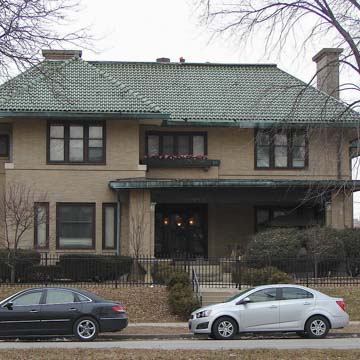This is Milwaukee’s largest Prairie Style house. The style was the most avant-garde architecture of its period, and the Weinhagen House features its Roman brick; overall horizontal emphasis; long, low roofline with broad fascia; extra-wide overhangs; continuous window rows; and restrained use of ornament. The carriage house was designed to match the main building. W. Highland Boulevard was an exclusive residential thoroughfare when Weinhagen built his house. Its appearance resulted from the Milwaukee Common Council’s innovative city planning. In 1896, the council designated this stretch of W. Highland as a grand parkway, creating a forty-foot-wide landscaped esplanade and banning freight traffic. The city created similar boulevards along McKinley and Newberry avenues. The city parkways beautified the densely packed city, encouraging upper-class residential construction on spacious lots by such local architects as Herman W. Buemming, Carl Barkhausen, and Ferry and Clas.
Weinhagen was born in 1859 in Hildesheim, in present-day Germany, and came to Milwaukee at the age of fifteen. Three years later he became the co-owner of a successful box-making business. After he died, his residence became a fraternity house, but it has been rehabilitated as an office building.


